Capstone I Research: Trauma in Transgender Youths and Mental Health
VerifiedAdded on 2022/08/20
|8
|1688
|16
Report
AI Summary
This report, prepared for a NURS 601 Capstone I assignment, investigates the prevalence and impact of trauma on transgender youths. It begins with an overview of the LGBT community, highlighting the challenges of homelessness, discrimination, and systemic barriers faced by transgender individuals, particularly the youth population. The report synthesizes existing literature, including studies on the relationship between discrimination, mental health, and trauma, with a focus on PTSD symptoms, suicidal tendencies, and substance use. The report explores the limitations of previous research and proposes an innovative approach to address gaps in existing studies. It also addresses the trauma-related factors associated with homelessness, such as bullying and lack of resources. The innovation section outlines the research proposal, emphasizing the need for face-to-face interviews to capture both verbal and non-verbal reactions of the sample. The study aims to identify the primary reasons for trauma in homeless transgender youths to design potential interventions that can improve their mental health and reduce related problems.
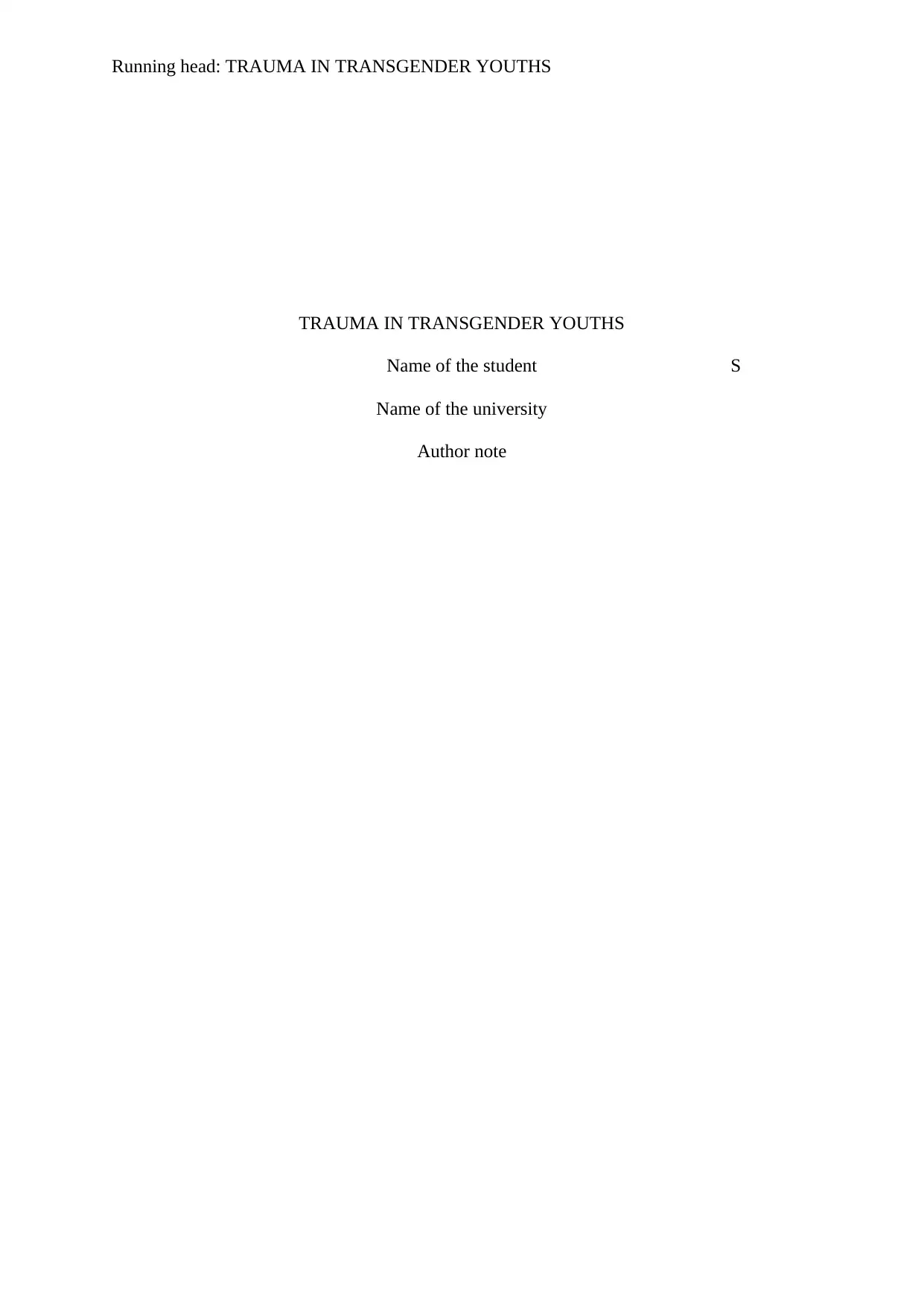
Running head: TRAUMA IN TRANSGENDER YOUTHS
TRAUMA IN TRANSGENDER YOUTHS
Name of the student S
Name of the university
Author note
TRAUMA IN TRANSGENDER YOUTHS
Name of the student S
Name of the university
Author note
Paraphrase This Document
Need a fresh take? Get an instant paraphrase of this document with our AI Paraphraser

1
TRAUMA IN TRANSGENDER YOUTHS
Table of Contents
Background:...............................................................................................................................2
Innovation:.................................................................................................................................4
References:.................................................................................................................................6
TRAUMA IN TRANSGENDER YOUTHS
Table of Contents
Background:...............................................................................................................................2
Innovation:.................................................................................................................................4
References:.................................................................................................................................6
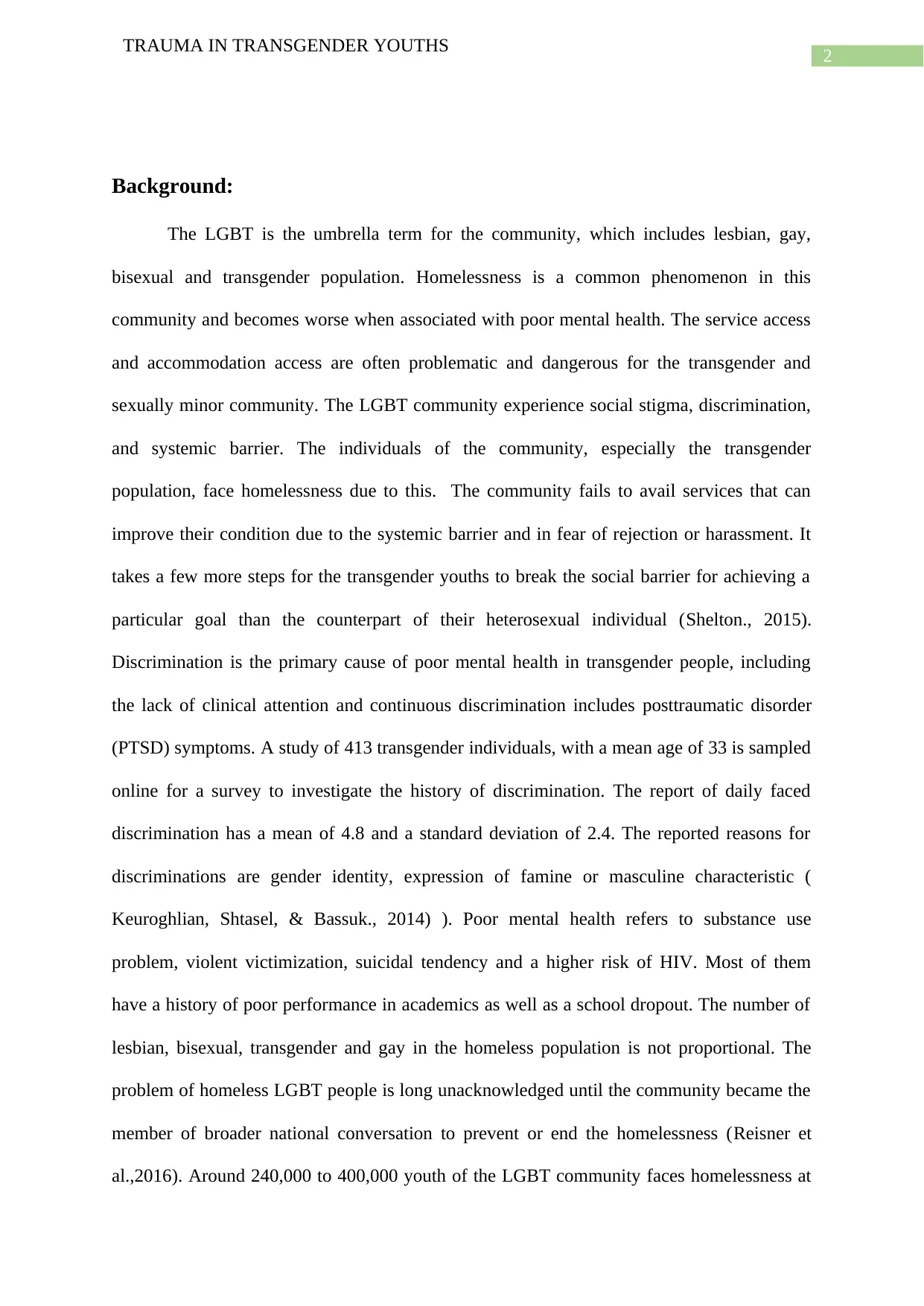
2
TRAUMA IN TRANSGENDER YOUTHS
Background:
The LGBT is the umbrella term for the community, which includes lesbian, gay,
bisexual and transgender population. Homelessness is a common phenomenon in this
community and becomes worse when associated with poor mental health. The service access
and accommodation access are often problematic and dangerous for the transgender and
sexually minor community. The LGBT community experience social stigma, discrimination,
and systemic barrier. The individuals of the community, especially the transgender
population, face homelessness due to this. The community fails to avail services that can
improve their condition due to the systemic barrier and in fear of rejection or harassment. It
takes a few more steps for the transgender youths to break the social barrier for achieving a
particular goal than the counterpart of their heterosexual individual (Shelton., 2015).
Discrimination is the primary cause of poor mental health in transgender people, including
the lack of clinical attention and continuous discrimination includes posttraumatic disorder
(PTSD) symptoms. A study of 413 transgender individuals, with a mean age of 33 is sampled
online for a survey to investigate the history of discrimination. The report of daily faced
discrimination has a mean of 4.8 and a standard deviation of 2.4. The reported reasons for
discriminations are gender identity, expression of famine or masculine characteristic (
Keuroghlian, Shtasel, & Bassuk., 2014) ). Poor mental health refers to substance use
problem, violent victimization, suicidal tendency and a higher risk of HIV. Most of them
have a history of poor performance in academics as well as a school dropout. The number of
lesbian, bisexual, transgender and gay in the homeless population is not proportional. The
problem of homeless LGBT people is long unacknowledged until the community became the
member of broader national conversation to prevent or end the homelessness (Reisner et
al.,2016). Around 240,000 to 400,000 youth of the LGBT community faces homelessness at
TRAUMA IN TRANSGENDER YOUTHS
Background:
The LGBT is the umbrella term for the community, which includes lesbian, gay,
bisexual and transgender population. Homelessness is a common phenomenon in this
community and becomes worse when associated with poor mental health. The service access
and accommodation access are often problematic and dangerous for the transgender and
sexually minor community. The LGBT community experience social stigma, discrimination,
and systemic barrier. The individuals of the community, especially the transgender
population, face homelessness due to this. The community fails to avail services that can
improve their condition due to the systemic barrier and in fear of rejection or harassment. It
takes a few more steps for the transgender youths to break the social barrier for achieving a
particular goal than the counterpart of their heterosexual individual (Shelton., 2015).
Discrimination is the primary cause of poor mental health in transgender people, including
the lack of clinical attention and continuous discrimination includes posttraumatic disorder
(PTSD) symptoms. A study of 413 transgender individuals, with a mean age of 33 is sampled
online for a survey to investigate the history of discrimination. The report of daily faced
discrimination has a mean of 4.8 and a standard deviation of 2.4. The reported reasons for
discriminations are gender identity, expression of famine or masculine characteristic (
Keuroghlian, Shtasel, & Bassuk., 2014) ). Poor mental health refers to substance use
problem, violent victimization, suicidal tendency and a higher risk of HIV. Most of them
have a history of poor performance in academics as well as a school dropout. The number of
lesbian, bisexual, transgender and gay in the homeless population is not proportional. The
problem of homeless LGBT people is long unacknowledged until the community became the
member of broader national conversation to prevent or end the homelessness (Reisner et
al.,2016). Around 240,000 to 400,000 youth of the LGBT community faces homelessness at
⊘ This is a preview!⊘
Do you want full access?
Subscribe today to unlock all pages.

Trusted by 1+ million students worldwide
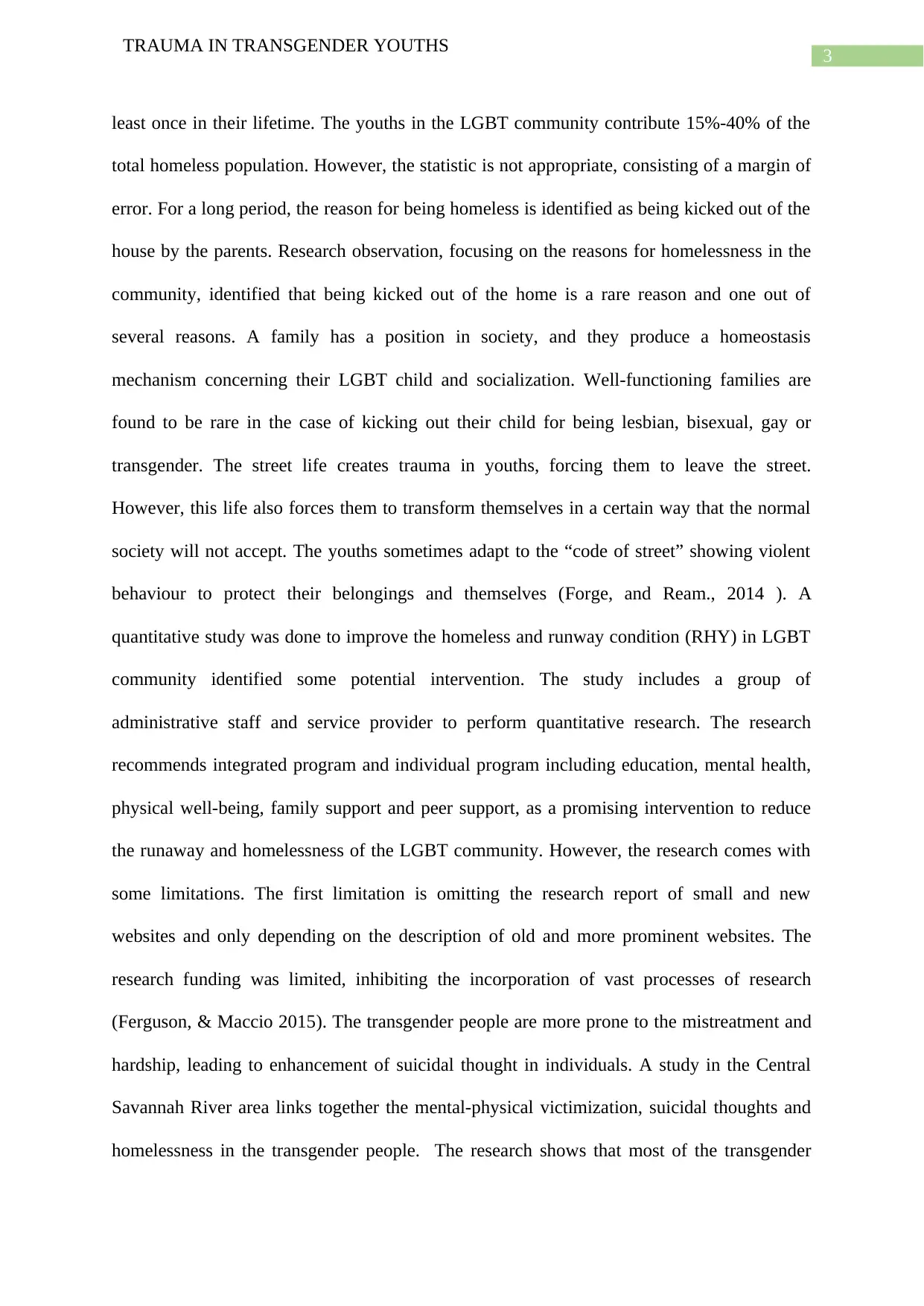
3
TRAUMA IN TRANSGENDER YOUTHS
least once in their lifetime. The youths in the LGBT community contribute 15%-40% of the
total homeless population. However, the statistic is not appropriate, consisting of a margin of
error. For a long period, the reason for being homeless is identified as being kicked out of the
house by the parents. Research observation, focusing on the reasons for homelessness in the
community, identified that being kicked out of the home is a rare reason and one out of
several reasons. A family has a position in society, and they produce a homeostasis
mechanism concerning their LGBT child and socialization. Well-functioning families are
found to be rare in the case of kicking out their child for being lesbian, bisexual, gay or
transgender. The street life creates trauma in youths, forcing them to leave the street.
However, this life also forces them to transform themselves in a certain way that the normal
society will not accept. The youths sometimes adapt to the “code of street” showing violent
behaviour to protect their belongings and themselves (Forge, and Ream., 2014 ). A
quantitative study was done to improve the homeless and runway condition (RHY) in LGBT
community identified some potential intervention. The study includes a group of
administrative staff and service provider to perform quantitative research. The research
recommends integrated program and individual program including education, mental health,
physical well-being, family support and peer support, as a promising intervention to reduce
the runaway and homelessness of the LGBT community. However, the research comes with
some limitations. The first limitation is omitting the research report of small and new
websites and only depending on the description of old and more prominent websites. The
research funding was limited, inhibiting the incorporation of vast processes of research
(Ferguson, & Maccio 2015). The transgender people are more prone to the mistreatment and
hardship, leading to enhancement of suicidal thought in individuals. A study in the Central
Savannah River area links together the mental-physical victimization, suicidal thoughts and
homelessness in the transgender people. The research shows that most of the transgender
TRAUMA IN TRANSGENDER YOUTHS
least once in their lifetime. The youths in the LGBT community contribute 15%-40% of the
total homeless population. However, the statistic is not appropriate, consisting of a margin of
error. For a long period, the reason for being homeless is identified as being kicked out of the
house by the parents. Research observation, focusing on the reasons for homelessness in the
community, identified that being kicked out of the home is a rare reason and one out of
several reasons. A family has a position in society, and they produce a homeostasis
mechanism concerning their LGBT child and socialization. Well-functioning families are
found to be rare in the case of kicking out their child for being lesbian, bisexual, gay or
transgender. The street life creates trauma in youths, forcing them to leave the street.
However, this life also forces them to transform themselves in a certain way that the normal
society will not accept. The youths sometimes adapt to the “code of street” showing violent
behaviour to protect their belongings and themselves (Forge, and Ream., 2014 ). A
quantitative study was done to improve the homeless and runway condition (RHY) in LGBT
community identified some potential intervention. The study includes a group of
administrative staff and service provider to perform quantitative research. The research
recommends integrated program and individual program including education, mental health,
physical well-being, family support and peer support, as a promising intervention to reduce
the runaway and homelessness of the LGBT community. However, the research comes with
some limitations. The first limitation is omitting the research report of small and new
websites and only depending on the description of old and more prominent websites. The
research funding was limited, inhibiting the incorporation of vast processes of research
(Ferguson, & Maccio 2015). The transgender people are more prone to the mistreatment and
hardship, leading to enhancement of suicidal thought in individuals. A study in the Central
Savannah River area links together the mental-physical victimization, suicidal thoughts and
homelessness in the transgender people. The research shows that most of the transgender
Paraphrase This Document
Need a fresh take? Get an instant paraphrase of this document with our AI Paraphraser
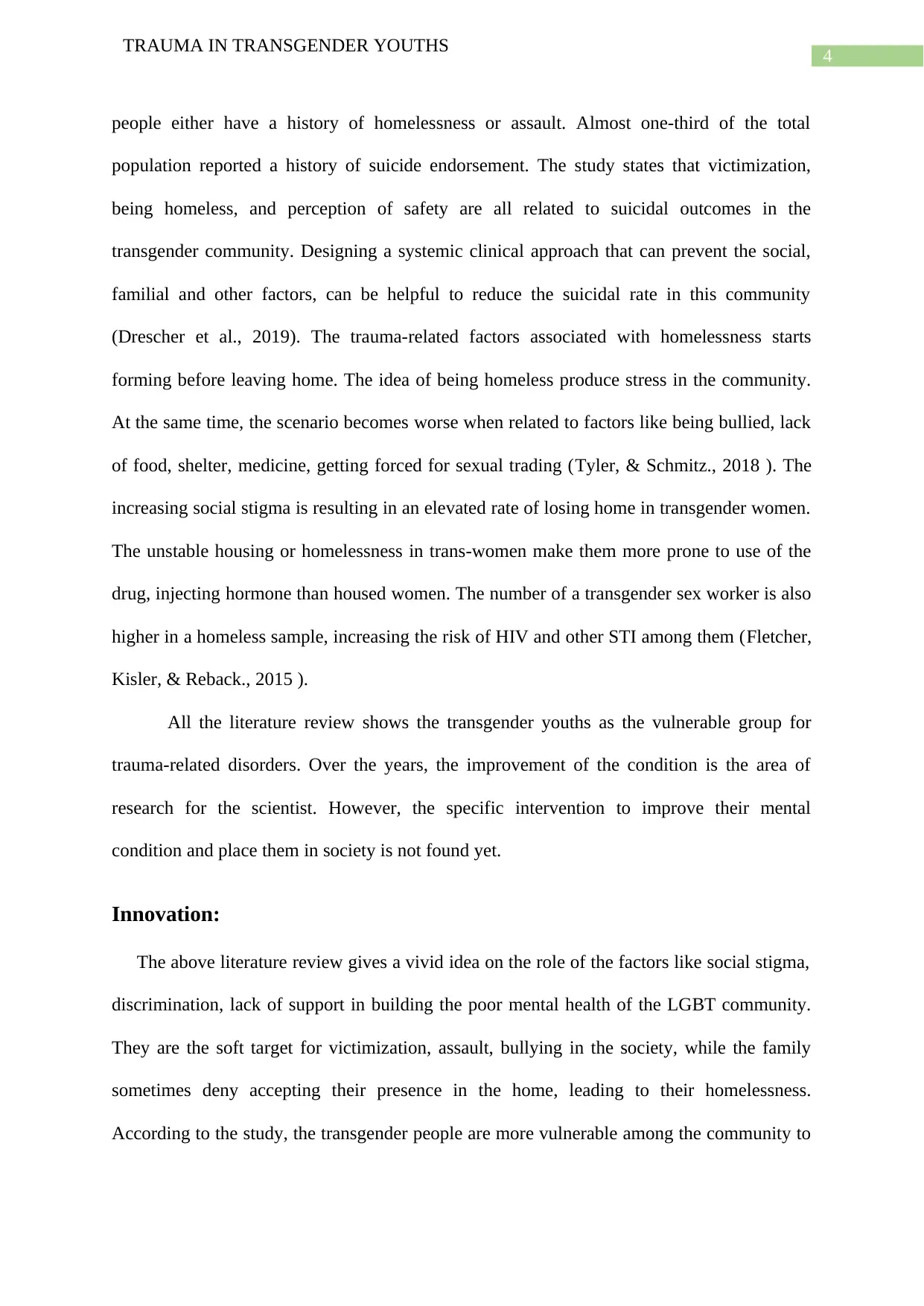
4
TRAUMA IN TRANSGENDER YOUTHS
people either have a history of homelessness or assault. Almost one-third of the total
population reported a history of suicide endorsement. The study states that victimization,
being homeless, and perception of safety are all related to suicidal outcomes in the
transgender community. Designing a systemic clinical approach that can prevent the social,
familial and other factors, can be helpful to reduce the suicidal rate in this community
(Drescher et al., 2019). The trauma-related factors associated with homelessness starts
forming before leaving home. The idea of being homeless produce stress in the community.
At the same time, the scenario becomes worse when related to factors like being bullied, lack
of food, shelter, medicine, getting forced for sexual trading (Tyler, & Schmitz., 2018 ). The
increasing social stigma is resulting in an elevated rate of losing home in transgender women.
The unstable housing or homelessness in trans-women make them more prone to use of the
drug, injecting hormone than housed women. The number of a transgender sex worker is also
higher in a homeless sample, increasing the risk of HIV and other STI among them (Fletcher,
Kisler, & Reback., 2015 ).
All the literature review shows the transgender youths as the vulnerable group for
trauma-related disorders. Over the years, the improvement of the condition is the area of
research for the scientist. However, the specific intervention to improve their mental
condition and place them in society is not found yet.
Innovation:
The above literature review gives a vivid idea on the role of the factors like social stigma,
discrimination, lack of support in building the poor mental health of the LGBT community.
They are the soft target for victimization, assault, bullying in the society, while the family
sometimes deny accepting their presence in the home, leading to their homelessness.
According to the study, the transgender people are more vulnerable among the community to
TRAUMA IN TRANSGENDER YOUTHS
people either have a history of homelessness or assault. Almost one-third of the total
population reported a history of suicide endorsement. The study states that victimization,
being homeless, and perception of safety are all related to suicidal outcomes in the
transgender community. Designing a systemic clinical approach that can prevent the social,
familial and other factors, can be helpful to reduce the suicidal rate in this community
(Drescher et al., 2019). The trauma-related factors associated with homelessness starts
forming before leaving home. The idea of being homeless produce stress in the community.
At the same time, the scenario becomes worse when related to factors like being bullied, lack
of food, shelter, medicine, getting forced for sexual trading (Tyler, & Schmitz., 2018 ). The
increasing social stigma is resulting in an elevated rate of losing home in transgender women.
The unstable housing or homelessness in trans-women make them more prone to use of the
drug, injecting hormone than housed women. The number of a transgender sex worker is also
higher in a homeless sample, increasing the risk of HIV and other STI among them (Fletcher,
Kisler, & Reback., 2015 ).
All the literature review shows the transgender youths as the vulnerable group for
trauma-related disorders. Over the years, the improvement of the condition is the area of
research for the scientist. However, the specific intervention to improve their mental
condition and place them in society is not found yet.
Innovation:
The above literature review gives a vivid idea on the role of the factors like social stigma,
discrimination, lack of support in building the poor mental health of the LGBT community.
They are the soft target for victimization, assault, bullying in the society, while the family
sometimes deny accepting their presence in the home, leading to their homelessness.
According to the study, the transgender people are more vulnerable among the community to
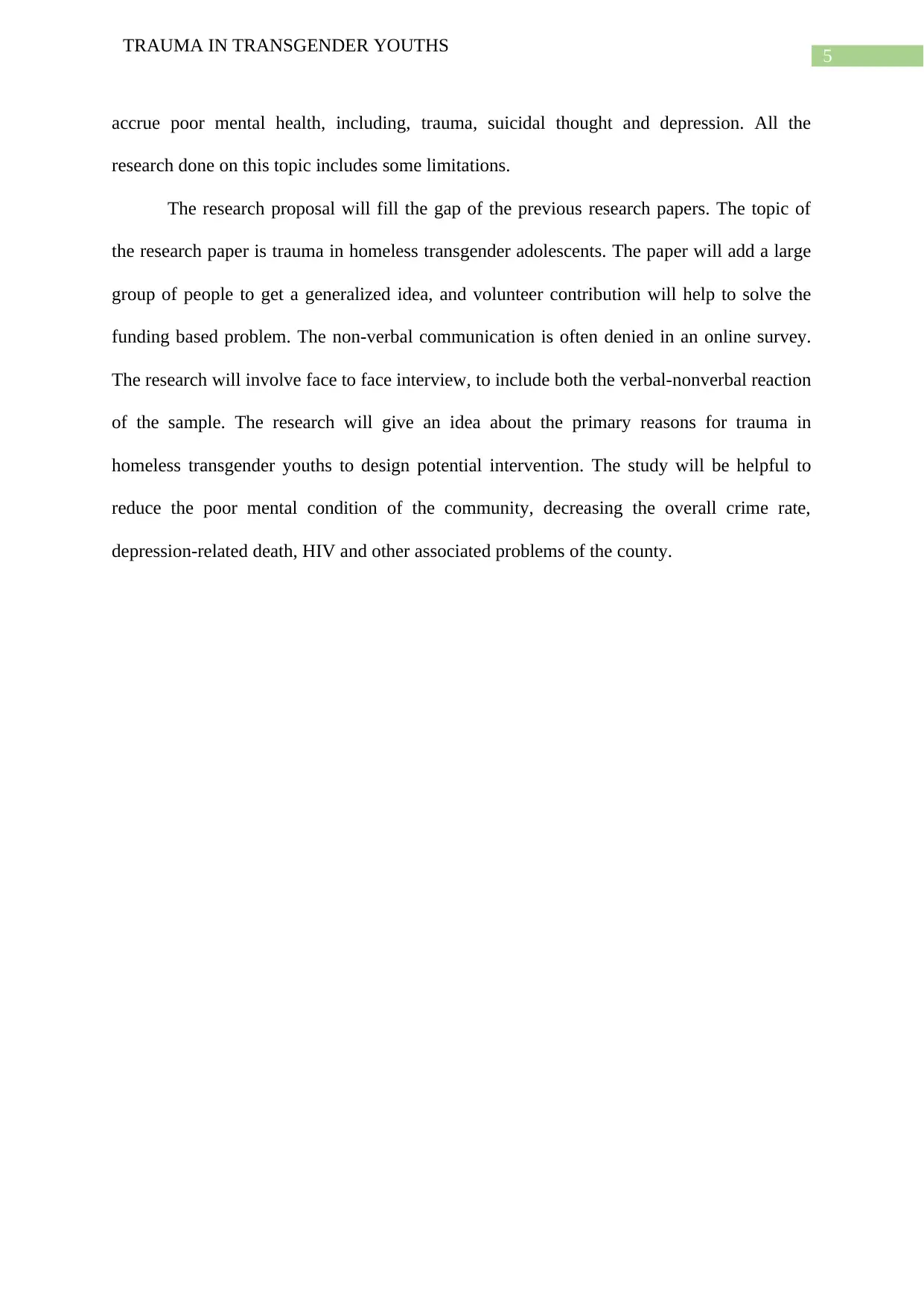
5
TRAUMA IN TRANSGENDER YOUTHS
accrue poor mental health, including, trauma, suicidal thought and depression. All the
research done on this topic includes some limitations.
The research proposal will fill the gap of the previous research papers. The topic of
the research paper is trauma in homeless transgender adolescents. The paper will add a large
group of people to get a generalized idea, and volunteer contribution will help to solve the
funding based problem. The non-verbal communication is often denied in an online survey.
The research will involve face to face interview, to include both the verbal-nonverbal reaction
of the sample. The research will give an idea about the primary reasons for trauma in
homeless transgender youths to design potential intervention. The study will be helpful to
reduce the poor mental condition of the community, decreasing the overall crime rate,
depression-related death, HIV and other associated problems of the county.
TRAUMA IN TRANSGENDER YOUTHS
accrue poor mental health, including, trauma, suicidal thought and depression. All the
research done on this topic includes some limitations.
The research proposal will fill the gap of the previous research papers. The topic of
the research paper is trauma in homeless transgender adolescents. The paper will add a large
group of people to get a generalized idea, and volunteer contribution will help to solve the
funding based problem. The non-verbal communication is often denied in an online survey.
The research will involve face to face interview, to include both the verbal-nonverbal reaction
of the sample. The research will give an idea about the primary reasons for trauma in
homeless transgender youths to design potential intervention. The study will be helpful to
reduce the poor mental condition of the community, decreasing the overall crime rate,
depression-related death, HIV and other associated problems of the county.
⊘ This is a preview!⊘
Do you want full access?
Subscribe today to unlock all pages.

Trusted by 1+ million students worldwide
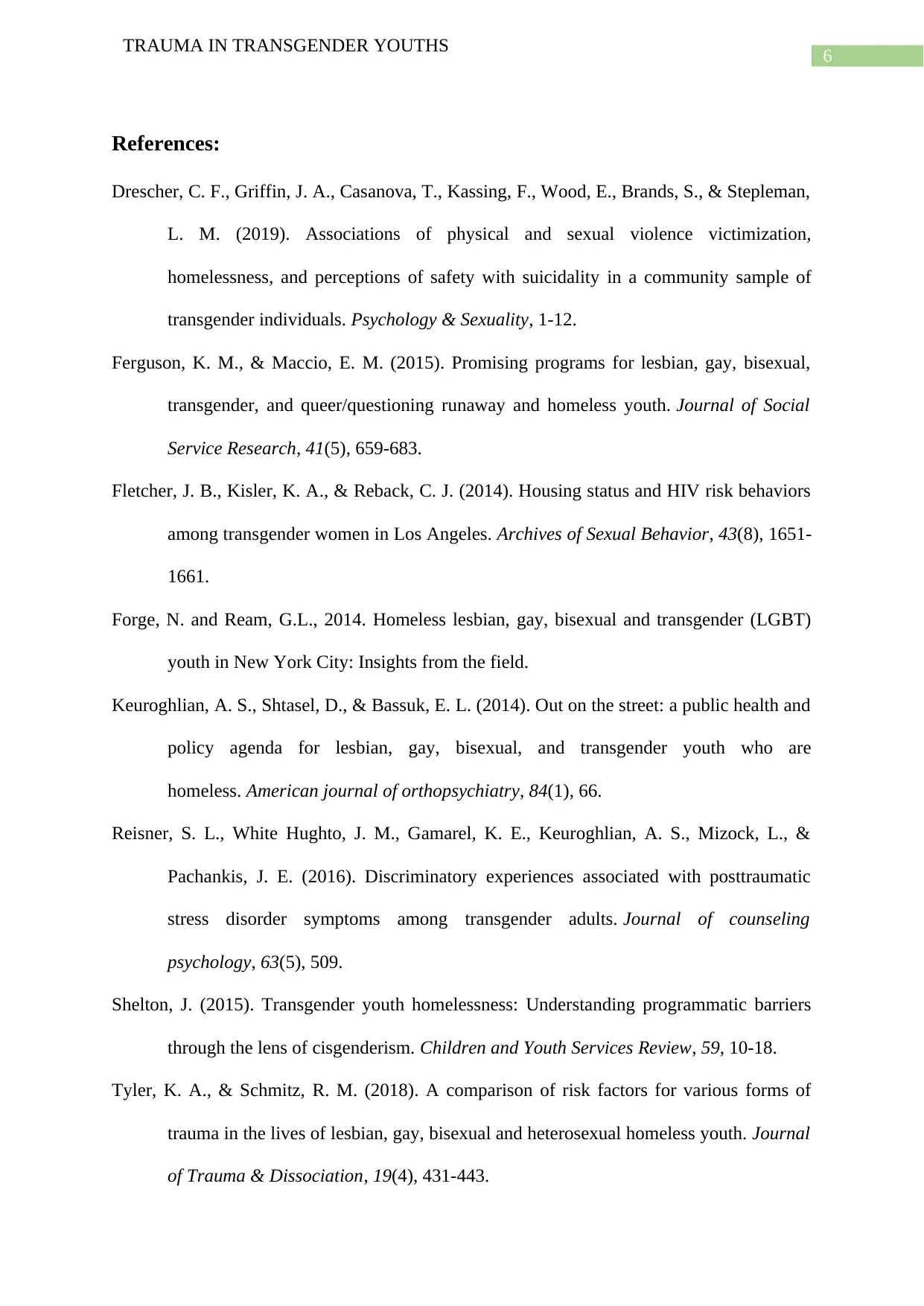
6
TRAUMA IN TRANSGENDER YOUTHS
References:
Drescher, C. F., Griffin, J. A., Casanova, T., Kassing, F., Wood, E., Brands, S., & Stepleman,
L. M. (2019). Associations of physical and sexual violence victimization,
homelessness, and perceptions of safety with suicidality in a community sample of
transgender individuals. Psychology & Sexuality, 1-12.
Ferguson, K. M., & Maccio, E. M. (2015). Promising programs for lesbian, gay, bisexual,
transgender, and queer/questioning runaway and homeless youth. Journal of Social
Service Research, 41(5), 659-683.
Fletcher, J. B., Kisler, K. A., & Reback, C. J. (2014). Housing status and HIV risk behaviors
among transgender women in Los Angeles. Archives of Sexual Behavior, 43(8), 1651-
1661.
Forge, N. and Ream, G.L., 2014. Homeless lesbian, gay, bisexual and transgender (LGBT)
youth in New York City: Insights from the field.
Keuroghlian, A. S., Shtasel, D., & Bassuk, E. L. (2014). Out on the street: a public health and
policy agenda for lesbian, gay, bisexual, and transgender youth who are
homeless. American journal of orthopsychiatry, 84(1), 66.
Reisner, S. L., White Hughto, J. M., Gamarel, K. E., Keuroghlian, A. S., Mizock, L., &
Pachankis, J. E. (2016). Discriminatory experiences associated with posttraumatic
stress disorder symptoms among transgender adults. Journal of counseling
psychology, 63(5), 509.
Shelton, J. (2015). Transgender youth homelessness: Understanding programmatic barriers
through the lens of cisgenderism. Children and Youth Services Review, 59, 10-18.
Tyler, K. A., & Schmitz, R. M. (2018). A comparison of risk factors for various forms of
trauma in the lives of lesbian, gay, bisexual and heterosexual homeless youth. Journal
of Trauma & Dissociation, 19(4), 431-443.
TRAUMA IN TRANSGENDER YOUTHS
References:
Drescher, C. F., Griffin, J. A., Casanova, T., Kassing, F., Wood, E., Brands, S., & Stepleman,
L. M. (2019). Associations of physical and sexual violence victimization,
homelessness, and perceptions of safety with suicidality in a community sample of
transgender individuals. Psychology & Sexuality, 1-12.
Ferguson, K. M., & Maccio, E. M. (2015). Promising programs for lesbian, gay, bisexual,
transgender, and queer/questioning runaway and homeless youth. Journal of Social
Service Research, 41(5), 659-683.
Fletcher, J. B., Kisler, K. A., & Reback, C. J. (2014). Housing status and HIV risk behaviors
among transgender women in Los Angeles. Archives of Sexual Behavior, 43(8), 1651-
1661.
Forge, N. and Ream, G.L., 2014. Homeless lesbian, gay, bisexual and transgender (LGBT)
youth in New York City: Insights from the field.
Keuroghlian, A. S., Shtasel, D., & Bassuk, E. L. (2014). Out on the street: a public health and
policy agenda for lesbian, gay, bisexual, and transgender youth who are
homeless. American journal of orthopsychiatry, 84(1), 66.
Reisner, S. L., White Hughto, J. M., Gamarel, K. E., Keuroghlian, A. S., Mizock, L., &
Pachankis, J. E. (2016). Discriminatory experiences associated with posttraumatic
stress disorder symptoms among transgender adults. Journal of counseling
psychology, 63(5), 509.
Shelton, J. (2015). Transgender youth homelessness: Understanding programmatic barriers
through the lens of cisgenderism. Children and Youth Services Review, 59, 10-18.
Tyler, K. A., & Schmitz, R. M. (2018). A comparison of risk factors for various forms of
trauma in the lives of lesbian, gay, bisexual and heterosexual homeless youth. Journal
of Trauma & Dissociation, 19(4), 431-443.
Paraphrase This Document
Need a fresh take? Get an instant paraphrase of this document with our AI Paraphraser

7
TRAUMA IN TRANSGENDER YOUTHS
TRAUMA IN TRANSGENDER YOUTHS
1 out of 8
Related Documents
Your All-in-One AI-Powered Toolkit for Academic Success.
+13062052269
info@desklib.com
Available 24*7 on WhatsApp / Email
![[object Object]](/_next/static/media/star-bottom.7253800d.svg)
Unlock your academic potential
Copyright © 2020–2025 A2Z Services. All Rights Reserved. Developed and managed by ZUCOL.





